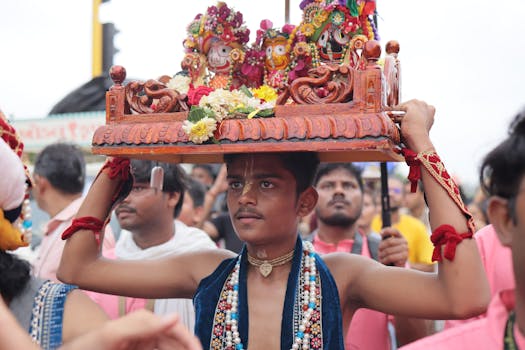
**
Jagannath Rath Yatra 2025: Unveiling the Mystical Symbolism of the Chariots and the Divine Procession
The vibrant spectacle of the Jagannath Rath Yatra, also known as the Rath Yatra Puri, is a deeply significant religious festival celebrated annually in Puri, Odisha, India. Scheduled for 2025, the Yatra promises to once again captivate millions with its breathtaking display of faith and devotion. But beyond the sheer visual grandeur, lies a rich tapestry of symbolism and spiritual meaning, particularly embodied in the majestic chariots themselves. This article delves into the core symbolism of the chariots and explores the profound significance of this divine procession.
The Three Chariots: A Trinity of Divine Energies
The heart of the Jagannath Rath Yatra lies in the three colossal chariots, each dedicated to a member of the divine trinity:
Nandighosa (Lord Jagannath's chariot): The largest of the three, Nandighosa symbolizes the power and majesty of Lord Jagannath, the presiding deity of Puri's Jagannath Temple. Its imposing size reflects the omnipotence of the Lord. The intricate carvings depict scenes from Hindu mythology, further enhancing its spiritual significance.
Taladhwaja (Lord Balabhadra's chariot): Representing Lord Balabhadra, Jagannath's elder brother, Taladhwaja signifies strength, stability, and the earthly realm. Its design often incorporates symbols of agriculture and prosperity, reflecting Balabhadra's association with these aspects.
Darpadalana (Devi Subhadra's chariot): The chariot of Devi Subhadra, Jagannath's sister, Darpadalana embodies grace, beauty, and the divine feminine energy. Its smaller size, compared to the others, underscores the delicate balance and importance of feminine power within the divine trinity.
Symbolism of the Chariots: Beyond the Divine Trinity
The chariots themselves are not merely vehicles; they are potent symbols with deeper layers of meaning:
The Journey to Gundicha Temple: The pulling of the chariots signifies the journey of the divine trinity from the Jagannath Temple to the Gundicha Temple, a temporary abode. This journey represents the cyclical nature of life, death, and rebirth – a central tenet of Hindu philosophy. The Gundicha Temple itself holds immense importance, as it's believed to be the place where the deities enjoy a temporary respite.
The Wheels of Time: The massive wheels of the chariots are symbolic of the wheel of time (kala chakra) continuously turning, representing the impermanence of all things and the continuous cycle of creation and destruction.
The Wooden Structure: The chariots are made of wood, a material that symbolizes the temporary nature of earthly existence, highlighting the transience of the material world in contrast to the eternal nature of the divine. This emphasizes the ephemeral nature of life and the importance of spiritual pursuits.
The Decoration and Art: The intricate carvings and vibrant decorations on the chariots are a stunning visual representation of the devotion and artistry of the people. They depict scenes from Hindu epics, further reinforcing the spiritual narrative and the richness of Indian culture. Understanding the iconography is key to appreciating the depth of symbolism.
The Significance of the Divine Procession: More Than Just a Festival
The Jagannath Rath Yatra is far more than just a religious festival; it's a grand celebration of faith, community, and cultural heritage. Millions of devotees participate, regardless of caste or creed, demonstrating the festival's power to unite people in shared reverence.
A Fusion of Faith and Festivity: The atmosphere is electrifying, with devotees chanting hymns, singing devotional songs (bhajans), and offering prayers. The air is filled with the aroma of incense and the vibrant colors of traditional attire. This fusion of spirituality and celebration is a powerful aspect of the experience.
A Demonstration of Faith: The act of pulling the chariots is considered a sacred duty, and devotees eagerly participate, viewing it as an opportunity to earn divine grace. This collective act of devotion demonstrates the immense faith of the people.
A Cultural Tapestry: The festival is also a vibrant display of Odisha's rich cultural heritage. Traditional music, dance, and cuisine are showcased, enriching the experience and providing a deeper understanding of the region's cultural identity. The Odia culture is deeply intertwined with this celebration.
Tourism and Economic Impact: The Jagannath Rath Yatra is also a significant tourism event, bringing in millions of visitors and boosting the local economy. The influx of pilgrims and tourists contributes significantly to the state's revenue and employment.
Jagannath Rath Yatra 2025: Preparing for the Grand Event
With the 2025 Jagannath Rath Yatra approaching, anticipation is building. The Odisha government and local authorities are already making preparations to ensure a smooth and safe pilgrimage for the millions expected to attend. Planning your trip in advance is crucial, as accommodation and transportation can be challenging during the peak season.
Learning about the historical context, the rituals, and the various aspects of the festival will enhance your experience and allow for a more meaningful participation. The history of Rath Yatra is fascinating and deeply rooted in Odisha's heritage.
The Jagannath Rath Yatra 2025 is a momentous occasion, a chance to witness a unique and profound display of faith, culture, and spirituality. By understanding the symbolism of the chariots and the significance of the procession, we can appreciate the depth and richness of this incredible event. So, plan your journey, immerse yourself in the vibrant atmosphere, and experience the magic of the Jagannath Rath Yatra.




















